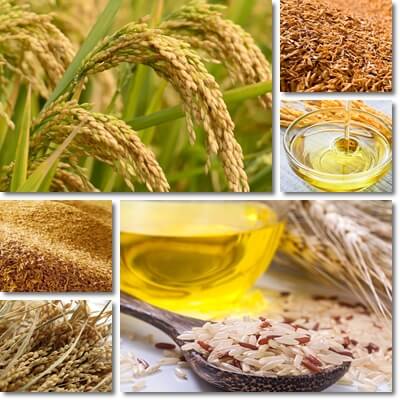What is rice bran oil?
Rice bran oil, known simply as rice oil, is an edible oil made from brown rice. As its name suggests, rice bran oil is made from rice bran which is the hard, inner brown husk of rice, and rice germ which is the embryo of the rice seed. Rice bran oil from commercial production is typically cold-pressed and solvent-extracted, either unrefined or refined, and is an excellent oil for cooking. One of the biggest benefits of rice bran oil is its high smoke point of over 230 degrees Celsius (or 450 degrees Fahrenheit) which makes it more stable during high-heat cooking.
What is rice bran oil made of?
As its name suggests, rice bran oil is made from rice bran, and also germ. But what kind of rice? The bulk of commercial rice bran oil is made from brown rice. Brown rice is a whole grain and contains bran and germ which are a source of oil. White rice is actually refined brown rice, that is, brown rice from which the outermost husk, bran and germ have been removed, so it can’t yield oil. Other varieties of rice such as red, purple and black rice can be a source of oil too, but their cultivation is limited which causes both the rice and the oil that can be extracted from these varieties to demand a too high a price on the market.

What does rice bran oil look like?
Rice bran oils is a yellow oil that looks a lot like sunflower oil. The degree of processing undergone can cause it to look differently. For example, cold-pressed unrefined rice bran oil looks more yellow, vs refined rice bran oil which is typically a paler yellow color to almost clear. Generally, the more refined an oil is, the paler its color. This is because refining often involves steps such as deodorizing and bleaching.
What does rice bran oil smell and taste like?
Rice bran oil is a non-fragrant or unscented oil, meaning it has no particular fragrance. It is however slightly odoriferous, with a typical oily smell, although some people find it downright odorless. As for flavor profile, rice bran oil doesn’t taste like anything particular which is why it’s favored for cooking, seeing that it leaves no flavor of its own on food. It has a rich and smooth texture.
Properties of rice bran oil
- Food-grade or edible oil and cooking oil.
- High smoke point oil, suitable for high-heat cooking.
- Carrier oil, non-fragrant/unscented and mild-flavored.
- Cosmetic oil, suitable for face, skin, hair and nail care.
- Cold-pressed oil, expeller-pressed and solvent-extracted.
- Unrefined OR refined (both options are available).
- Vegetal oil, made from a plant source.
- High unsaturated fat oil (75% unsaturated fatty acids content).
- Non-GMO oil as opposed to cooking oils such as soybean oil or corn.
- High vitamin E-oil with antioxidant and emollient properties.
- Lightweight, gets absorbed quickly and easily into the skin, moisturizing properties.
- Low-allergenic oil.

Uses of rice bran oil
- Uses for high-heat cooking: Rice bran oil is a good oil to use for high-heat cooking such as stir-frying, sauteing, deep-frying because of its high smoke point (over 230 degrees Celsius, or 450 degrees Fahrenheit).
- Uses for face: Not only can you apply rice bran oil directly to the face, but it’s also a light and moisturizing oil, great for dry skin and skin care during winter. It’s also a great oil for oily or mixed skin because it both gets absorbed quickly into the skin and doesn’t leave a greasy finish. Good for face cleansing and removing makeup.
- Uses for skin care: Can be used directly on the skin, it’s lightweight and gets absorbed easily. Fairly unlikely to cause skin allergic reactions, irritation, burns or redness (although possible). Can be used for dry skin, cracked skin and as a massage oil.
- Uses for hair care: Rice bran oil used for hair care softens and moisturizes and may potentially induce new growth.
- Uses for nail care: Can be used for dry hands, cracked skin on hands, brittle nails and cuticle care.
- Carrier oil for diluting essential oils. Generally safe to use directly on the skin, rice bran oil makes a great carrier oil for diluting essential oils.
- Source of the dietary supplement known as γ-oryzanol. Used as a nutritional supplement.
Rice bran oil nutrition facts for 100 g
- Energetic value: 884 kcal (kilocalories)
- Total Fat Content: 100 g
- Polyunsaturated Fat: 35 g – 37 g (linoleic acid, Omega-6 and alpha-linolenic acid, Omega-3)
- Monounsaturated Fat: 38 g – 39.3 g (oleic acid, Omega-9)
- Saturated Fat: 19.7 g – 25 g (palmitic, stearic acid, myristic)
- Cholesterol: 0 g
- Vitamin E (alpha-tocopherol): 32.3 mg
- Vitamin K (phylloquinone): 24.7 mcg (micrograms)
- Iron: 0.07 mg
Is rice bran oil healthy?
Here are all the reasons why rice bran oil is healthy:
- Reason 1: Source of healthy fats, rice brain oil is high in unsaturated fatty acids (high in Omega-9 and Omega-6) and contains small amounts of ALA Omega-3 fatty acids (around 2 g/100 g).
- Reason 2: High smoke point (230 degrees Celsius, or 450 degrees Fahrenheit) – this makes it great for high-heat cooking because it is more stable and less likely to produce harmful compounds.
- Reason 3: High in vitamin E (over 200% daily requirements of vitamin E per 100 g).
- Reason 4: High in vitamin K (27.4% of daily vitamin K requirements for adult women and 20.5% for men).
- Reason 5: Source of γ-Oryzanol which is a nutraceutical.
- Reason 6: Cholesterol-free.
- Reason 7: Has antioxidant, moisturizing, softening and soothing properties.
- Reason 8: Generally safe to use directly on the skin.
- Reason 9: Has anti-inflammatory properties.
- Reason 10: It’s non GMO, meaning not genetically modified.
What are the benefits of Rice Bran Oil?
- Rice bran oil benefits cardiovascular health as a result of its high unsaturated fat content.
- Exerts anti-inflammatory properties with benefits for cardiovascular health.
- Potential lowering-cholesterol properties from γ-Oryzanol (gamma-Oryzanol) and Omega-3.
- Brain food – as a fat, rice bran oil feeds the brain and supports cognitive functions such as memory, thinking, attention etc. and helps combat brain fog.
- Benefits for the nervous system: vitamin E helps with proper conduction of electrical impulses along nerves, contributing to normal neuromotor function, while unsaturated fats help build up nerve cell membrane.
- Helps delay cognitive decline. Fats are physically part of our brain cells. Studies show getting enough fats in our diet helps delay cognitive decline and maintain cognitive function.
- Benefits for the immune system thanks to a high vitamin E content.
- Good for dry, cracked skin, rice bran oil moisturizes and soothes skin.
- Antioxidant and anti-aging properties from vitamin E and unsaturated fatty acids.
- Anti-wrinkle effect – fats nourish and plump skin, contributing to cell membranes and helping skin cells retain moisture.
- Softens hair, smooths hair cuticle, nourishes and hydrates dry hair, restores shine to listless, devitalized hair.
- May potentially induce new hair growth.
- Potential benefits for acne due to rice bran oil being lightweight and easily absorbed into the skin, meaning it doesn’t clog pores.
- Supports blood coagulation thanks to high vitamin K content.
Note: To get the most of the benefits of rice bran oil, it’s best to choose one that is cold-pressed and unrefined. Refining typically takes away from the nutritional status of oils and removes some of the antioxidants occurring naturally in the oils.
What are the side effects of Rice Bran Oil?
Rice bran oil can be a healthy addition to one’s diet, provided it is consumed in small amounts. Potential side effects may include:
- Weight gain, if intake is excessive, and associated side effects (e.g. increased risk of metabolic diseases such as diabetes, heart disease).
- Allergic reactions. Although generally safe to use directly on the skin, it is possible in rare instances for rice bran oil to cause skin allergy symptoms, including redness, itching, bumps or burns.
